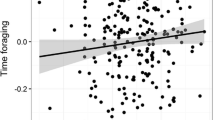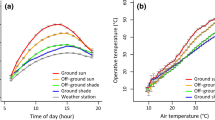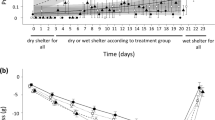Summary
Yellow-bellied marmots (Marmota flaviventris) were studied at three sites in central Oregon. Juveniles substantially reduced their foraging activity when equivalent black-body temperatures exceeded their upper critical temperature. Inclusion of heat stress into estimates of environmental harshness drastically reduced the differences in available foraging time between high elevation and low elevation sites.
Similar content being viewed by others
References
Anderson, D.C., Armitage, K.B., Hoffman, R.S.: Socioecology of marmots: Female reproductive strategies. Ecology 57, 552–560 (1976)
Armitage, K.B.: Social behavior and population dynamics of marmots. Oikos 26, 341–354 (1975)
Armitage, K.B.: Social variety in the yellow-bellied marmot: a population-behavioral system. Anim. Behav. 25, 585–593 (1977)
Bakken, G.S.: A heat transfer analysis of animals: unifying concepts and the application of metabolism chamber data to field ecology. J. Theor. Biol. 60, 337–384 (1976)
Barash, D.P.: The social biology of the Olympic marmot. Anim. Behav. Monogr. 6, 171–245 (1973a)
Barash, D.P.: Social variety in the yellow-bellied marmot (Marmota flaviventris). Anim. Behav. 21, 579–584 (1973b)
Barash, D.P.: The evolution of marmot societies: A general theory. Science 185, 415–420 (1974)
Barash, D.P.: Ecology of paternal behavior in the hoary marmot (Marmota caligata): An evolutionary interpretation. J. Mammal. 56, 613–618 (1975)
Campbell, G.S.: An introduction to environmental biophysics. Berlin-Heidelberg-New York: Springer-Verlag (1977)
Gagge, A.P.: Standard operative temperature, a generalized temperature scale, applicable to direct and partial calorimetry. Amer. J. Physiol. 131, 93–103 (1940)
Horwitz, W. (ed.): Official methods of analysis of the association of Official Analytical Chemists. Association of Official Analytical Chemists (1970)
Kilgore, D.L.: Energy dynamics of the yellow-bellied marmot (Marmota flaviventris): A hibernator. Ph. D. thesis. Univ. of Kansas (1972)
Kilgore, D.L., Armitage, K.B.: Energetics of yellow-bellied marmot populations. Ecology 59, 78–88 (1978)
Mahoney, S.A., King, J.R.: The use of equivalent black-body temperature in the thermal energetics of small birds. J. Thermal Biol. 2, 115–120 (1977)
Michell, J.W.: Heat transfer from spheres and other animal forms. Biophysical J. 16, 561–569 (1976)
Monteith, J.L.: Principles of environmental physics. New York Elsevier (1973)
Porter, W.P., Gates, D.M.: Thermodynamic equilibria of animals with environment. Ecol. Monogr. 39, 227–244 (1969)
Webb, D.R.: manuscript. Macro-habitat patch structure, environmental harshness and social behavior in the yellow-bellied marmot
Winslow, C.E.A., Herrington, L.P., Gagge, A.P.: Physiological reactions of the human body to varying environmental temperatures. Amer. J. Physiol. 120, 1–22 (1937)
Author information
Authors and Affiliations
Rights and permissions
About this article
Cite this article
Webb, D.R. Environmental harshness, heat stress, and Marmota flaviventris . Oecologia 44, 390–395 (1979). https://doi.org/10.1007/BF00545243
Received:
Issue Date:
DOI: https://doi.org/10.1007/BF00545243




